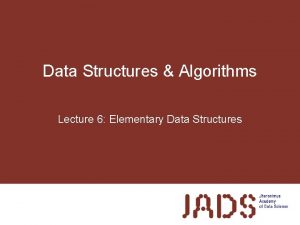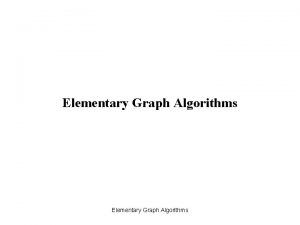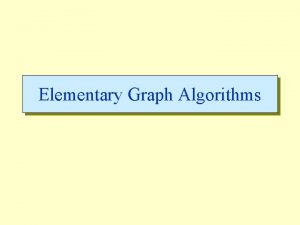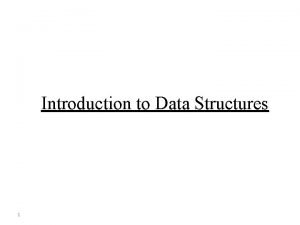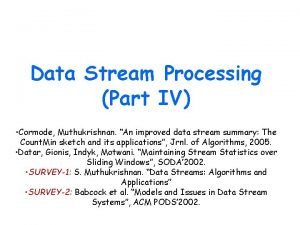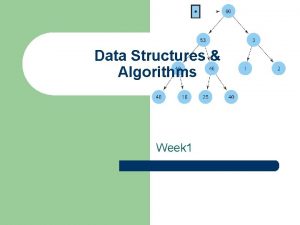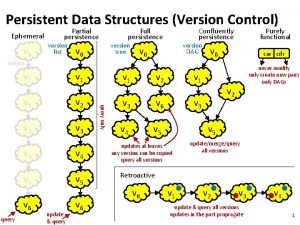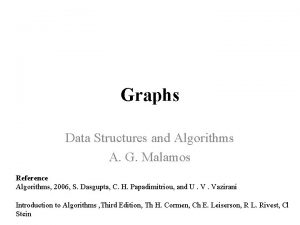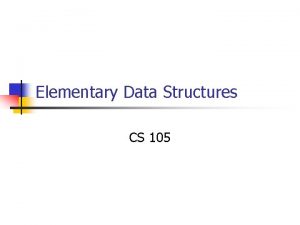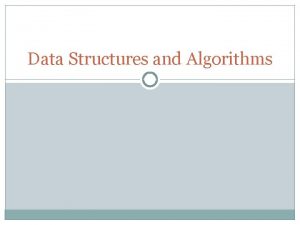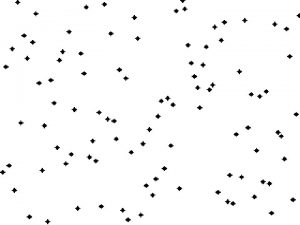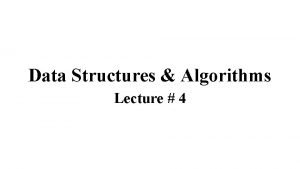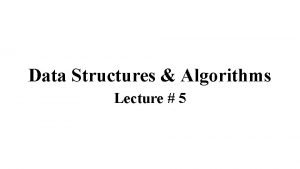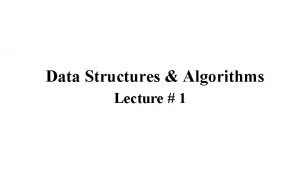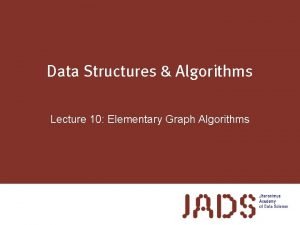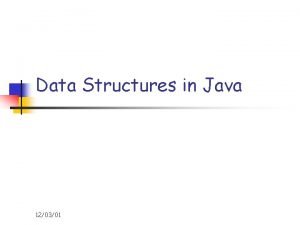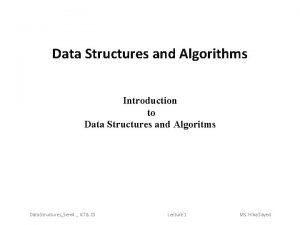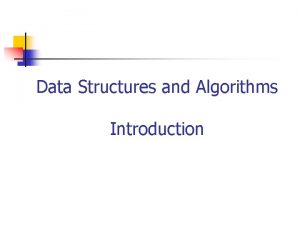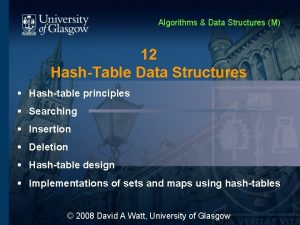Elementary Data Structures and Algorithms A G Malamos



























- Slides: 27

Elementary Data Structures and Algorithms A. G. Malamos

Basic Set Operations on a dynamic set can be grouped into two categories: queries, which simply return information about the set, and modifying operations, which change the set. SEARCH. S, k INSERT. S, x DELETE. S, x MINIMUM. S MAXIMUM. S SUCCESSOR. S, x PREDECESSOR. S, x References: Introduction to Algorithms , Third Edition, Th H. Cormen, Ch E. Leiserson, R L. Rivest, Cl Stein

Stacks and queues In a stack, the element deleted from the set is the one most recently inserted: the stack implements a last-in, first-out, or LIFO, policy. Similarly, in a queue, the element deleted is always the one that has been in the set for the longest time: the queue implements a first-in, first-out, or FIFO, policy. The INSERT operation on a stack is often called PUSH, and the DELETE operation, which does not take an element argument, is often called POP

Stacks and queues We call the INSERT operation on a queue ENQUEUE, and we call the DELETE operation DEQUEUE; like the stack operation POP, DEQUEUE takes no element argument. The FIFO property of a queue causes it to operate like a line of customers waiting to pay a cashier. The queue has a head and a tail.

Linked lists A linked list is a data structure in which the objects are arranged in a linear order. Unlike an array, however, in which the linear order is determined by the array indices, the order in a linked list is determined by a pointer in each object Linked lists provide a simple, flexible representation for dynamic sets, supporting all the set operations listed

Searching a linked list To search a list of n objects, the LIST-SEARCH procedure takes O(n) in the worst case, since it may have to search the entire list.

Inserting into a linked list INSERT on a list of n elements is O(1)

Deleting from a linked list LIST-DELETE runs in. O(1), but if we wish to delete an element with a given key O(n) is required in the worst case because we must first call LIST-SEARCH to find the element.

Sentinels A sentinel is a dummy object that allows us to simplify boundary conditions. The attribute L: nil: next points to the head of the list, and L: nil: prev points to the tail.

Representing rooted trees We represent each node of a tree by an object. As with linked lists, we assume that each node contains a key attribute. The remaining attributes of interest are pointers to other nodes, and they vary according to the type of tree. Fortunately, there is a clever scheme to represent trees with arbitrary numbers of children. It has the advantage of using only O(n) space for any n-node rooted tree. In the left-child, right-sibling representation each node contains a parent pointer p, and T: root points to the root of tree T. Instead of having a pointer to each of its children, however, each node x has only two pointers: 1. x: left-childpoints to the leftmost child of node x, and 2. x: right-sibling points to the sibling of x immediately to its right. If node x has no children, then x: left-child=NIL, and if node x is the rightmost child of its parent, then x: right-sibling=NIL.

left-child, right-sibling examples

Assignment 1, Exercise 1 To deliver in 2 weeks (between 29 and 31 of Oct)

Direct-address tables Direct addressing is a simple technique that works well when the universe U of keys is reasonably small.

Hash tables The downside of direct addressing is obvious: if the universe U is large, storing A table T of size |U| may be impractical, or even impossible. With direct addressing, an element with key k is stored in slot k. With hashing, this element is stored in slot h(k) that is, we use a hash function h to compute the slot from the key k. Here, h maps the universe U of keys into the slots of a hash Table T (0…m-1) There is one hitch: two keys may hash to the same slot. We call this situation A collision. Fortunately, we have effective techniques for resolving the conflict created by collisions.

Using a hash function h to map keys to hashtable slots. Because keys k 2 and k 5 map to the same slot, they collide. Collision resolution by chaining.

Perfect hashing Although hashing is often a good choice for its excellent average-case performance, hashing can also provide excellent worst-case performance when the set of keys is static: once the keys are stored in the table, the set of keys never changes We call a hashing technique perfect hashing O(1) memory accesses are required to perform a search in the worst case. To create a perfect hashing scheme, we use two levels of hashing, with universal hashing at each level.

How Hashing works Interpreting keys as natural numbers Most hash functions assume that the universe of keys is the set N[0, 1, 2…. ] of natural numbers. Thus, if the keys are not natural numbers, we find a way to interpret them as natural numbers. For example, we can interpret a character string as an integer expressed in suitable radix notation. The division method In the division method for creating hash functions, we map a key k into one of m slots by taking the remainder of k divided by m. That is, the hash function is H=k mod m The multiplication method for creating hash functions operates in two steps. First, we multiply the key k by a constant A in the range 0<A<1 and extract the fractional part of k*A. Then, we multiply this value by m and take the floor of the result. In short, the hash function is H=m*(k*A mod 1) Universal hashing In universal hashing, at the beginning of execution we select the hash function at random from a carefully designed class of functions

Assignment 1 Exercises 2 11. 3 -1 Suppose we wish to search a linked list of length n, where each element contains a key k along with a hash value h(k). Each key is a long character string. How might we take advantage of the hash values when searching the list for an element with a given key?

Binary Search Trees The search tree data structure supports many dynamic-set operations, including SEARCH, MINIMUM, MAXIMUM, PREDECESSOR, SUCCESSOR, INSERT, and DELETE. Thus, we can use a search tree both as a dictionary and as a priority queue. Basic operations on a binary search tree take time proportional to the height of the tree. For a complete binary tree with n nodes, such operations run in O(log 2(n)) worst-case time. If the tree is a linear chain of n nodes, however, the same operations take O(n) worst-case time.

What is a binary tree A binary search tree is organized, in a binary tree, as shown in Figure. We can represent such a tree by a linked data structure in which each node is an object. In addition to a key and satellite data, each node contains Attributes left, right, and p that point to the nodes corresponding to its left child, its right child, and its parent, respectively. Let x be a node in a binary search tree. If y is a node in the left subtree Of x, then y. key<=x. key. If y is a node in the right subtree of x, then y. key>=x. key

Binary Search Tree Walk The binary-search-tree property allows us to print out all the keys in a binary search tree in sorted order by a simple recursive algorithm, called an inorder tree walk.

Searching We use the following procedure to search for a node with a given key in a binary search tree. Given a pointer to the root of the tree and a key k, TREE-SEARCH returns a pointer to a node with key k if one exists; otherwise, it returns NIL. The nodes encountered during the recursion form a simple path downward from the root of the tree, and thus the running time of TREESEARCH is O(h), where h is the height of the tree.

Minimum and maximum Both of these procedures run in O(h) time on a tree of height h since, as in TREESEARCH, the sequence of nodes encountered forms a simple path downward from the root.

Successor and predecessor We break the code for TREE-SUCCESSOR into two cases. If the right subtree of node x is nonempty, then the successor of x is just the leftmost node in x’s right subtree, which we find in line 2 by calling TREEMINIMUM(x. right). The running time of TREE-SUCCESSOR on a tree of height h is O(h), since we either follow a simple path up the tree or follow a simple path down the tree. The procedure TREE-PREDECESSOR, which is symmetric to TREE-SUCCESSOR, also runs in time O(h) Theorem 12. 2 We can implement the dynamic-set operations SEARCH, MINIMUM, MAXIMUM, SUCCESSOR, and PREDECESSOR so that each one runs in O(h) time on a binary search tree of height h.

Insertion The operations of insertion and deletion cause the dynamic set represented by a binary search tree to change. The data structure must be modified to reflect this change, but in such a way that the binary-search-tree property continues to hold. Like the other primitive operations on search trees, the procedure TREE-INSERT runs in O(h) time on a tree of height h. Inserting an item with key 13 into a binary search tree. Lightly shaded nodes indicate the simple path from the root down to the position where the item is inserted. The dashed line indicates the link in the tree that is added to insert the item

Deletion The procedure for deleting a given node z from a binary search tree T takes as arguments pointers to T and z. Deletion is done by considering the four cases shown. Theorem 12. 3 We can implement the dynamic-set operations INSERT and DELETE so that each one runs in O(h) time on a binary search tree of height h.

Assignment 1 Exercise 3
 Ajit diwan
Ajit diwan Cos 423
Cos 423 Data structures and algorithms tutorial
Data structures and algorithms tutorial Information retrieval data structures and algorithms
Information retrieval data structures and algorithms Data structures and algorithms bits pilani
Data structures and algorithms bits pilani Ajit diwan
Ajit diwan Data structures and algorithms
Data structures and algorithms Data structures and algorithms
Data structures and algorithms Waterloo data structures and algorithms
Waterloo data structures and algorithms Information retrieval data structures and algorithms
Information retrieval data structures and algorithms Data structures and algorithms
Data structures and algorithms Algorithms + data structures = programs
Algorithms + data structures = programs Elementary data structures
Elementary data structures Elementary data structures
Elementary data structures Topological sort演算法
Topological sort演算法 W graph
W graph Homologous structures
Homologous structures What is elementary data organization in data structure
What is elementary data organization in data structure Data stream
Data stream Conditional macro expansion in system software
Conditional macro expansion in system software Assembler data structures
Assembler data structures Data structures and abstractions with java
Data structures and abstractions with java Adts, data structures, and problem solving with c++
Adts, data structures, and problem solving with c++ Data structures and algorithm
Data structures and algorithm Ephemeral data structure
Ephemeral data structure Computational thinking algorithms and programming
Computational thinking algorithms and programming Design and analysis of algorithms syllabus
Design and analysis of algorithms syllabus Association analysis: basic concepts and algorithms
Association analysis: basic concepts and algorithms













